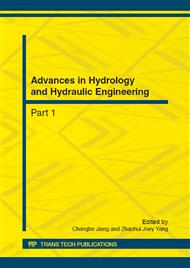p.1043
p.1048
p.1057
p.1062
p.1067
p.1071
p.1076
p.1083
p.1092
Study on the Downstream Surface Flow Pattern Critical Water Depth of the Hydropower Station
Abstract:
Through hydraulic model test of Tianqiao hydropower station reinforcement project, the empirical equations of the surface flow pattern critical water depth were proposed and validated. Some factors affecting the change of the surface flow pattern critical water depth were analyzed. The results show that the critical water depth values will decrease gradually when the nose angle change from zero degree to fifteen degrees. Lengthening the protection-apron and flow expansion will result in the ascent of the critical water depth values, which will descend if the bed level is reduced or the nose height is increased.
Info:
Periodical:
Pages:
1067-1070
Citation:
Online since:
October 2012
Authors:
Price:
Сopyright:
© 2012 Trans Tech Publications Ltd. All Rights Reserved
Share:
Citation:


